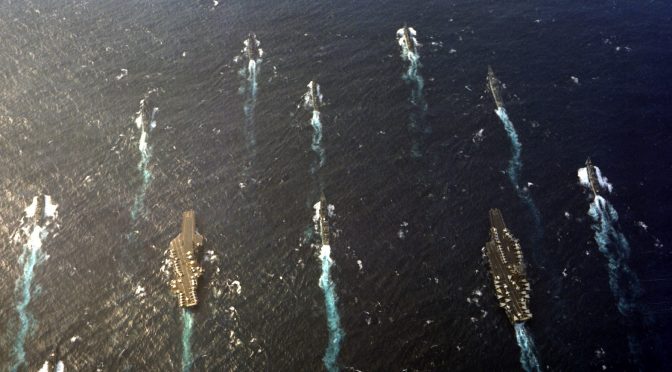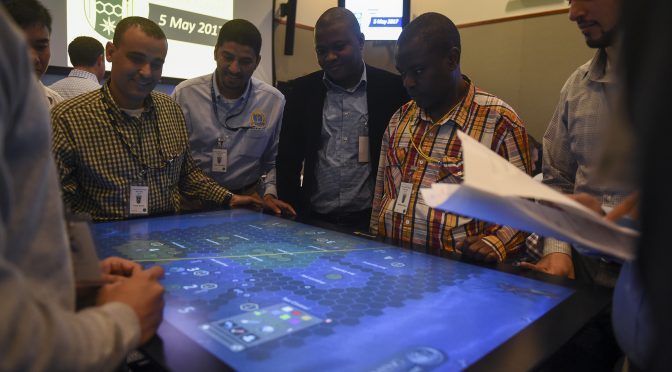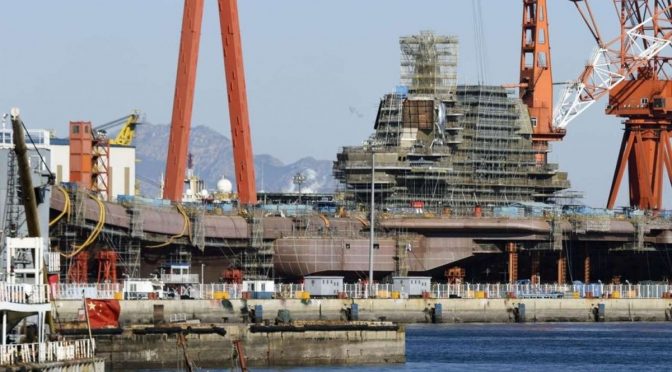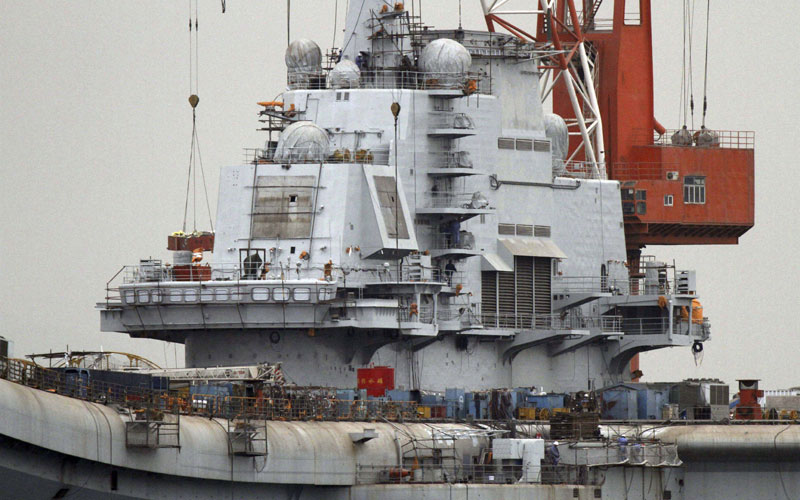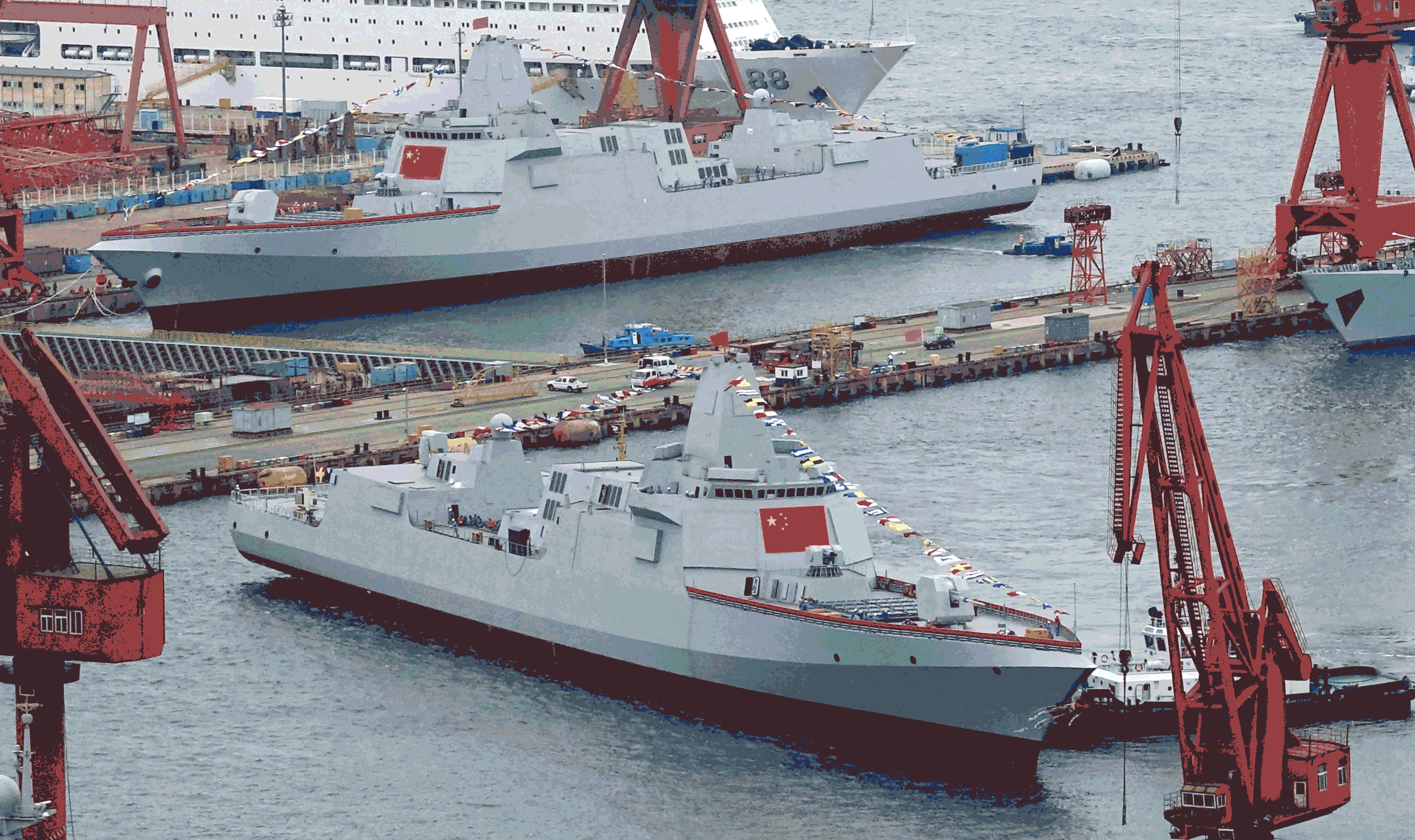Vice Admiral Hank Mustin earned a reputation as a hard-charging commander and a cunning tactical innovator. At the apex of his career in the 1980s Cold War U.S. Navy, Admiral Mustin played a critical role in the Navy’s force development. From developing new tactics to organizing large-scale fleet exercises, to introducing new weapons and drafting requirements for future warship types, Mustin was at the very forefront of naval force development in an era of great power competition.
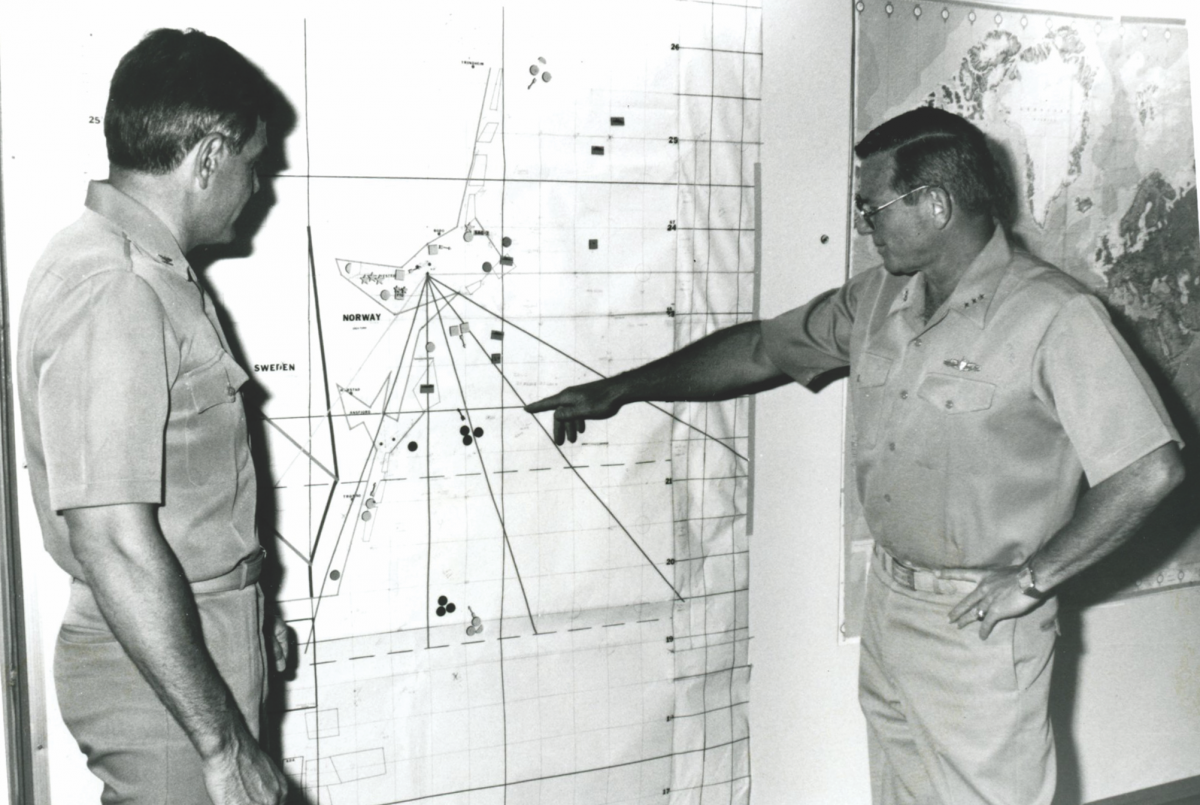
His legacy still lives on, and his work helped inspire the current Pacific Fleet’s “Fighting Instructions.” Below are select excerpts from Admiral Mustin’s Oral History, conducted by Dave Winkler of the Naval Historical Foundation and republished with permission. In these excerpts, Mustin shares his experiences and insights on leading naval force development, experimenting with new weapons, and how generating fresh tactical insight can make friends and foes in some of the most powerful places.
The great majority of the time was put into the development of this whole new bag of anti-air warfare tactics. There was not a lot of attention paid to anti-surface tactics or naval gunfire support because the feeling was that they would be handled by carrier aircraft…
…the fleet commander’s role in this stuff was essentially limited, because he was concerned with the operation of the force that he had, not the generation of a bunch of new tactics for new ships. So the majority of the tactical development at the time was done by the type commanders. That changed later on to be the fleet commanders bag, for the good reason that as we got into this stuff we found that, in particular, AAW was not the private purview of the surface Navy. You had to be able to integrate. As our own and the Soviet missile ranges got longer and longer your chances of shooting down your own airplanes, blue on blue, correspondingly increased. So the interplay between the surface ships and the carrier air wings got to be a very significant and difficult part of that equation. That was beyond the scope of the surface type commander’s authority. Because now you had two type commanders: the aviation type commander and the surface guys. So the fleet commander had to referee all those issues…
…Then the Arab-Israeli crisis of ’73 erupted. And to our amazement the Soviets put ninety-nine ships in the Mediterranean. There was no NATO involved in this so it was a U.S.-only operation. The first phase of the operation that involved the U.S. was the resupply of fighter aircraft to the Israelis. No cooperation from Spain, no cooperation from NATO. The replacement aircraft would TransLant and then go to ports in Italy. The function of the Sixth Fleet was to make sure that they could do that without the Soviet Navy interfering.
The Soviet Navy was an amazingly powerful unit—submarines, cruisers, all of whom were equipped with varying degrees of anti-surface missiles. It became apparent very quickly as we surge deployed our own forces that we had no tactics to deal with the defense of the fleet against these modern anti-surface missiles, because we’d been spending the last decade doing nothing but shooting at the Vietnamese ashore, and flying air strikes at Haiphong and Hanoi with no opposing fleet to stimulate fleet-on-fleet tactics. The whole body of tactics and weaponry and the modus operandi of the fleet was really in its formative stages. It caught both the aviation and the surface communities very, very much short…
…Luckily for the U.S. and for NATO, that [Arab-Israeli ’73] crisis tamped itself down without any shots being fired. What we got out of that was a huge bag of lessons, most of which showed how prescient Bud Zumwalt and Worth Bagley’s views about the rise of the Soviet Navy had been. Nobody believed them before all of this, in particular how important the rules of engagement were, the fact that we were not oriented or trained or properly indoctrinated to deal with fleet-on-fleet engagements, and how we had been way, way behind in the game of how to deal with these anti-surface missiles, largely because the aviators had just said: ‘Hey, we’ll sink everything before they have a chance to shoot at us,’ which of course ignored the rules of engagement…
…So really, after we got them up to those stages we started to work seriously on this bag of tactics that was so inadequate. The operations officer of the Sampson was a lieutenant named Neil Byrne. He had invented a dice game that you played on the wardroom table with ship models. He outlined all the capabilities, as we knew them, of the Soviet ships and ours, and you played tactical games. It’s called NavTag. Later on, when I was Op 35, we brought Neil back to OpNav, automated his game, and installed one of them at the Naval Academy and one at the War College. So that people started playing it. But at this time it was played on the wardroom table with dice. We started first as a competition between the ships. The wardrooms ate it up; they loved it.
Then we started a project where we played all the Type Commander’s TacNotes, and eighty percent of them were no good at all. We very carefully documented why we said this, and sent all this stuff to the Type Commander’s staff, who did not really welcome them in the spirit intended. Then we played ComSixthFlt’s anti-tattletale tactics, which is where we reached the fundamental but previously overlooked conclusion that you couldn’t get there from here if you tried to deal with the tattletales solely with carrier air…
…I learned in that tour in OpNav, particularly as Op 35, the tremendous potential of the whole new family of weapons systems that were on the verge of entering the surface Navy. They included the Tomahawk missile and the Harpoon, guided projectiles, electronic warfare systems such as the SLQ-32, and towed arrays for ASW. All these things were poised to enter the fleet.
But the fleet is not an experimental unit. Because the fleet has to maintain proficiency with the weapons that it has, and not play imaginary games with death rays from outer space and things like that. So while we were on the verge of providing this hardware, which in my view would change the nature of surface warfare forever, we were not doing anything in the fleet to develop the new tactics to use these weapons. So I determined when I got my orders, thanks to Jim Doyle, to be a CruDes Group commander, that I would focus very heavily on the tactical development, and the things that you could do as these new weapons were introduced.
At the same time, I could see that there was an enormous infrastructure built up to deal with the engineering status of the fleet. The PEB, that I think I told you I had been responsible for initially, had grown into an enormous bureaucracy, but there was no counterpart in the area of weapons or weapons development. So there was no clearinghouse for any of these tactics, the maintenance procedures were not established, and so we were really starting off from ground zero. The organization of the type commanders’ staffs, the capabilities and the imagination and the knowledge of the people in the staff structure had to be developed from the bottom up, because all these weapons were being introduced from the top down…
…I was able to focus more and more on the tactics, because the innovations of the PEB had now brought the engineering readiness of these ships up to a status where we didn’t have to worry so much about whether they could get underway, but rather what they would do after they got underway. So I started to work on the Tomahawk tactics and the AAW tactics as my highest priority.
I was more and more aware about how much resistance there was to the Tomahawk in surface ships. The CNO was resistant. He thought it was an unnecessary drain on naval aviation. Admiral Holloway, whom I dearly love, had referred to the Tomahawk as a silver bullet that we just didn’t need, in Congressional testimony. This is not conducive to high morale if you are a Tomahawk advocate. Anyway, I went out to work on Tomahawk tactics, which involved a lot of pretending. The trick was to work on maintaining proficiency with the things that we had, but at the same time incorporating into each exercise some of this “Let’s pretend we have Tomahawk” stuff, so we can see what we’re doing.
The first time we did this, I had a carrier down in the Caribbean working, and we were going to go down and join them for a FleetEx. I arranged with the CarGroup commander that on the way down we would conduct a force opposition drill. The carrier would come out and try to sink my flagship, and we would try to locate and sink the carrier. Everybody said: Great; great exercise. So we went out in Bill Peerenboom’s ship, and took five ships to go down for this. We went down in electronic silence and along the coast. The carrier couldn’t find us. In the meantime we had sent a couple of submarines down, and they located the carrier. So they were keeping us informed of the carrier’s position and we were still in silence. The carrier air wing was searching all over the Atlantic Ocean and couldn’t find us, because we had very carefully gone in one of these merchant routes.
When we reached Tomahawk range we fired not only on the submarine-reported position, but on electronic signals that we received from the carrier at long range. We fired what we called six Tomahawks; then we rolled the dice and said: Okay, two of them hit. Then we found out what the carrier had been doing at that time, and it turned out that they’d had a bunch of airplanes on deck, and things like that.
When we got down there I went over and saw the admiral on the carrier, and I said, “Hey, here’s the way the exercise worked out, as I see it. We fired these simulated missiles, and rolled the dice. Here’s what we had for your position.” He checked it, and said, “Hey, you had us.”
So I wrote up a personal message to ComSecondFlt, Tom Bigley, and told him all this. I said, “I think that we’re on the verge of something here that’s really going to change naval warfare. It shows that surface combatants now will have the capability to engage at long range a vastly superior force.” At the time we were worried about the Kiev, the Soviet nuclear-powered cruisers, and the Soviet carriers, which were coming into their inventory. I worded this very carefully. I put in the message that the CarGroup commander concurred with this message, after he’d said that he did, and sent it off to ComSecondFlt. Tom Bigley thought it was great. He was a surface warfare guy. A few weeks later a couple of officers came down from OpNav. They had heard about this. One of them was in OLA, the Office of Legislative Affairs, liaison with Congress. I told them about the exercise, and they asked me for a copy of this message. I made a mistake and gave it to them.
The message ended up on the Hill, in the hands of Tony Battista, who was running the R&D for, I think the House Armed Services Committee, or Senate Armed Services Committee—one of the authorization committees. He was on the civilian staff. That message came back to really bite me later on, because it really irritated the CNO, who wanted to spend more money on aviation programs than on cruise missiles, and who also was very sensitive to issues of carrier vulnerability…
About this time Ace Lyons was Commander Second Fleet. He said that he wanted to run a little exercise, carrier versus carrier, when the Forrestal out-chops from the Med. He would run this exercise so that the Eisenhower, the newest of our carriers, and the Forrestal will have a carrier-versus-carrier exercise when the Eisenhower’s on her way to northern Europe. And he would like me to take my staff and fly back over to Rota, get on board the Forrestal as she left the Med, and run the Forrestal air wing. So I said: Great. I flew back over in a C-5 with the staff and we picked up the Forrestal when she left the Med, now out of Sixth Fleet’s bailiwick and under CinCLantFlt’s bailiwick, and Com Second Fleet, Ace.
I gave my staff the following guidance: “What we’re going to do is, operate in total electronic silence.” This exercise had to be weapons that you had—you couldn’t pretend you had any new stuff. “We’re going to take our Harpoon escorts and we’re going to peel them off, three of them; send them way up north to the GIUK gap; and then, in electronic silence, just have them drift down with the merchant traffic as it comes down out of the gap into the central Atlantic; and we will see if, through electronic deception: number one, we can remain hidden in the Forrestal from the Ike’s aircraft, and number two, if you shooters, by mingling in with the fairly heavy merchant traffic and remaining silent, can get close enough to the Ike to shoot Harpoons at them.” Well, it worked like a champ. The carrier-versus-carrier exercises in the past had just been a bunch of guys revealing their positions, launching strikes at each other, and then saying, “Hah, hah. I bagged you…’”
The Ike’s aircraft couldn’t find us in the Forrestal. We weren’t flying. We were just drifting along near the coast. They were looking for us coming out of the Med, and not for this group coming down from the GIUK gap. And they were looking for a battle group, and not a bunch of scattered single contacts that were camouflaged in the pretty heavy traffic. So before they found us, two of our Harpoon shooters got in and launched simulated Harpoons at the carrier, from point-blank range in the middle of the night…
…And rolled the dice and said, “Okay, here’s how many times we bagged you,” and your airplanes were on deck. Well, wrote that report up and sent it off to ComSecondFlt, Ace.
That became a very contentious exercise, because the Ike was brand new and the funding for the new carriers was at issue. This was deemed by senior aviators to be a very inflammatory exercise, because it highlighted the vulnerability of the carrier to a determined enemy who was going to employ electronic deception and use anti-ship missiles. So Ace delayed and delayed and delayed the exercise report. The drafts would come back and I would keep changing them to say we hit and severely damaged the carrier, and it would have been out of action for x hours. Those remarks kept getting deleted from the final report of the exercise.
And I kept hearing these rumors that were getting stronger by the minute that I was going to retire. It turned out, and I didn’t know this, that Dave Johnson, who was SurfLant, and Harry Train, who was CinCLantFlt, were told by the CNO that he didn’t have a job for me. When he says that, you’re finished…
…But that’s the fine line that you walk. Really, people around very senior people— and you see this not just in the Navy or other Services but in the White House—the rumor mills poison the well for you. You walk a very difficult line, particularly when you’re at the front edge of innovation. You find a lot of guys who get ahead to very senior positions by never making any waves and by perpetuating the status quo. That’s the easy way, because while you don’t make powerful advocates, you don’t make powerful enemies either. All it takes is a couple of those powerful enemies when you’re in the rarified atmosphere of the flag business, and you’re out of there…
…One of the things I found, for example, was that no one in the Second Fleet, and by extension in the Navy, was really working on how to do war-at-sea strikes against modern Soviet forces. The aviation type commanders essentially were concerned, properly, with aviation safety. So that when you were a carrier skipper, AirLant’s principal concern was that you got everybody into the air and then you got them back on board safely. Once they were airborne and they went off to drop their bombs and do their things, that was not really the type commander’s concern. So each of the carrier air group commanders had his own set of tactics.
All of the tactics, for example, in the war-at-sea strikes started off with the assumption that they knew where the enemy was. Well, I was mindful that in the Battle of Midway, and in the tactical preparations before that battle, in the late thirties, the aviators developed a bunch of tactics which essentially said that the torpedo planes went in low and the dive bombers came in high at the same time, and the enemy was forced to split his battery and couldn’t figure out where to put his combat aircraft patrol. So he was either going to be dive-bombed or torpedoed, and everybody got his Legion of Merit and they loved these tours.
Well then at the Battle of Midway they didn’t really know where the enemy carriers were. As a result, the torpedo planes got there first. So I used to say that if you want to talk about the efficacy of that particular assumption, that you know where he is, let’s get hold of Ensign George Gay and discuss it with him. Because he’s the only guy left out of Torpedo Squadron 8. So we’re going to change all these tactics. You’re going to start off with the assumption that you don’t know where he is, and you’re going to combine search and attack tactics.
Well that changed everything. Then we took all of their tactics—by this time I had gotten Neil Byrne, the inventor of NavTag on my staff and he had automated it, put it in the computer—and we played all of the aviators’ war-at-sea strike tactics in the computer, to figure out which one of these eight carrier air group commanders had a set of tactics that made any sense against Soviet modern SAM defenses. We picked the best tactic, which not surprisingly was the one developed by Commander Art Cebrowski. That became the Second Fleet war-at-sea tactic. So we did all that kind of stuff, an awful lot of it. The aviators loved this. It was an interesting viewpoint from which to be able to watch how the surface type commander and the aviation type commander and the submarine type commander stayed within their own little pookas until somebody mixed them all. That’s the role of the fleet commander…
…We had the first two-Aegis ship exercise. There was a big debate about how you use Aegis—whether you used it away from the carrier to manage what was then called the outer air battle, or you used it in close to the carrier just to shoot at incoming missiles. My view was that if you used it in close to the carrier you weren’t using an Aegis ship, you were using an SM-1 ship. So it ought to be used to manage the air battle, because we had determined that, to handle massed Backfire raids, you had to engage these guys essentially before they fired. That meant that you had to engage them at a couple of hundred miles.
I went back to my Vietnam experience. The big concern about the Seawolf helicopters had been that their legs were too short. But what happened on every occasion was they went out and they expended all their ammunition long before they ran out of fuel. So there are all these tactics that had these carrier air patrol stations out at hundreds of miles, and the aviators were looking at these as a problem of keeping them re-tanked and refueled. But in these NavTag war games we showed that that wasn’t the problem at all. The problem was they shot up their load of Sparrows and Sidewinders instantly, and then they had to come back a couple of hundred miles, and you had to have more airplanes with weapons on the way, and there was no way to tank weapons. So a whole set of tactics flowed from that that were very different from the existing long-range engagement tactics. In order to do what I just said, you needed the capabilities of something like Aegis to manage the problem, with the Spy system. So we worked on that. We then, at the same time, were working on these long-range air strikes.
I set up a four-carrier exercise off the east coast and one down in the Caribbean. This was to show what carrier air power could do, and it was a very high visibility exercise in the political arena. We had a map of the east coast and we would hit targets up and down the east coast, widely separated, so that it would be impossible for an enemy to target them all, let alone find them with enough accuracy to launch missiles. The idea was that all four carrier air wings’ strikes would occur within a five-minute window. One of them was a thousand miles long. Dick Dunleavy was the CarGru commander who was in overall charge of this.
Anyway, we ran this wonderful exercise. We took it over to Congress and showed how we could have gone into St. Louis, Missouri, and made a couple of statements which really caught their eye. Four carrier air wings now possess the ordnance strike capability of 800 B-17s. I’d go over to Congress and say: You guys all remember these newsreel photos of World War II where the skies are full of B-17s going over Germany. Well, we can do that with four carriers. And nobody can target multiple carrier locations, so the carrier vulnerability issue is way over-exaggerated. So don’t cut the carrier forces. Interestingly, as a surface warfare officer, I was becoming the Navy’s principal spokesman in support of aircraft carriers.
But anyway, management of the outer air battle with the Spy-1 and the Aegis was magnificent. It changed everything. It impressed Jim Watkins so much, because he was having a big flailex with Aegis funding at the time, that he asked me to write him a personal letter. So I wrote him a letter and said, “This is so spectacular that I’m taking the unusual step of writing you personally. The detailed reports of these exercises will follow.” Then I wrote about a two-page letter that was deliberately designed to be Unclass and understandable, in language that a layman could understand. He entered that in the Congressional Record, and Aegis sailed through, for that and other reasons.
Henry C. Mustin was born in Bremerton, Washington on 31 August 1933, the son, grandson, and great-grandson of distinguished naval officers. (The Guided Missile Destroyer DDG 89 has been named for the Mustin family.) He graduated from Coronado High School, Coronado, California, in 1950 and attended the University of Virginia for one year prior to entering the U.S. Naval Academy. He was graduated and commissioned an Ensign 3 June 1955. He retired 1 January 1989.
Vice Admiral Mustin, a destroyerman, served at sea in the Pacific and Atlantic Fleets in USS Duncan (DDR 874); as Commanding Officer USS Bunting (MHC 45); as a plankowner in both USS Lawrence (DDG 4) and USS Conyngham (DDG 17); as Commanding Officer USS Henry B. Wilson (DDG 7); as Commander, Destroyer Squadron 12, homeported in Athens, Greece; as Commander, Cruiser Destroyer Group 2; and as Commander, U.S. Second Fleet and NATO Striking Fleet Atlantic (225 ships and 2100 aircraft over 45 million square miles from the Arctic Ocean to the Equator.)
He served ashore in Vietnam with the Delta River Patrol Group; as Flag Lieutenant to the Commander-in-Chief Pacific; as Executive Assistant to the Commander-in-Chief U.S. Naval Forces Europe; as Director, Surface Combat Systems Division in the Office of Chief of Naval Operations; as Deputy Commander Naval Surface Force, Atlantic Fleet; as Naval Inspector General; and as Deputy Chief of Naval Operations (Plans, Policy, and Operations).
He was responsible for the development of requirements and fleet introduction of the Tomahawk missile, the Standard missile (SM 2), LAMPS helicopters, and the Ticonderoga-class AEGIS cruisers. He was instrumental in defining the initial requirements for the Arleigh Burke-class destroyers.
Vice Admiral Mustin directed all U.S. Navy arms control planning, including the START negotiations with the Soviet Union. He led high level U.S. interagency delegations to Moscow, London, Paris, Lisbon, Oslo, and Seoul. He also served as the Senior U.S. Military Representative to the United Nations.
He was married to the former Lucy Holcomb of Alexandria, Virginia. They have three sons, a daughter, and nine grandchildren. He passed away on 11 April 2016.
David F. Winkler earned his Ph.D. in 1998. from American University in Washington, DC. He has been a historian with the non-profit Naval Historical Foundation for over two decades. His dissertation Cold War at Sea: High Seas Confrontation between the U.S. and Soviet Union was published by the Naval Institute Press in 2000, was republished under the title Incidents at Sea: American Confrontation and Cooperation with Russia and China, 1945 – 2016 in December 2017. He was selected in early 2019 to be the Class of 1957 Chair of Naval Heritage at the U.S. Naval Academy for the 2019-2020 academic year and the Charles Lindbergh Fellow at the Smithsonian National Air and Space Museum for the following year. Winkler received his commission as a Navy ensign in 1980 through the NROTC unit at the Pennsylvania State University. In addition to a B.A. in Political Science, he has an M.A. in International Affairs from Washington University. He is a retired Navy Reserve commander.
Featured Image: The U.S. Navy aircraft carriers USS Enterprise (CVN-65) and USS Midway (CV-41) underway in the Pacific Ocean with their task groups in 1982.

